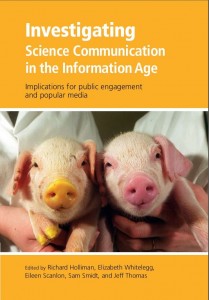Investigating Science Communication in the Information Age: Introduction
How are policy changes affecting how scientists engage with publics? How are digital technologies influencing how scientists disseminate their work and knowledge? How are emerging media platforms changing the way publics interact with scientific information?

Investigating Science Communication in the Information Age: Implications for Public Engagement and Popular Media. Holliman et al., 2009
Published in 2009 Investigating Science Communication in the Information Age is a collection of commissioned chapters by leading science communication scholars. The book addresses theoretical, practical and policy developments in science communication, including calls for greater openness and transparency; and engagement and dialogue on the part of professional scientists with members of the public.
The book provides a wide-ranging review of contemporary issues in science communication, focusing on two broad themes.
- The first theme critically reviews the recent ‘dialogic turn’ and ascendant branding of ‘public engagement with science’. It addresses contemporary theoretical and conceptual issues facing science communication researchers, and draws on a range of methodological approaches and examples.
- The second theme, popular media, examines recent trends in the theory and research of these forms of science communication. It includes contemporary accounts of the study of ‘traditional’ forms of popular media, including television and newspapers, examining how they are produced, represented and consumed. This theme also documents examples where novel forms of popular media are challenging researchers to re-think how they approach these forms of science communication.
Practising Science Communication in the Information Age: Introduction
What is the impact of open access on science communication? How can scientists effectively engage and interact with publics? What role can science communication have when scientific controversies arise?

Practising Science Communication in the Information Age: Theorising Professional Practices. Holliman, et al. 2009
Practising science communication in the information age is a collection of commissioned chapters by leading scholars and practitioners of science communication.
Published in 2009 the book considers how scientists communicate with each other as part of their professional practice, critically evaluating how this forms the basis of the documenting of scientific knowledge, and investigating how open access publication and open review are influencing current practices. The chapters also explore how science communication can play a crucial role when science is disputed, investigating the role of expertise in the formation of scientific controversy and consensus.
The volume provides a theoretically informed review of contemporary trends and issues that are engaging practitioners of science communication, focusing on issues such as the norms and conventions governing the practices of science communication, and how scientists communicate between disciplines.
Other topics that receive critical treatment include: peer review, open access publication, the protection of intellectual property, the formation of scientific controversy and consensus, the popularisation of science, and the practices of public engagement.
